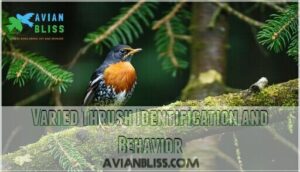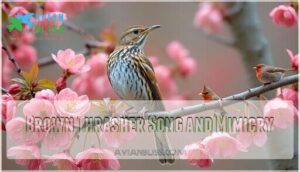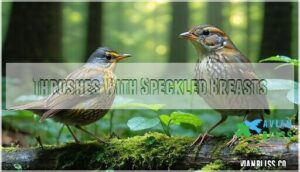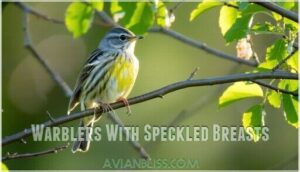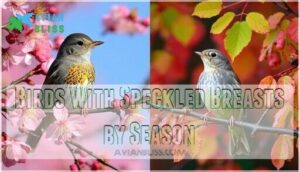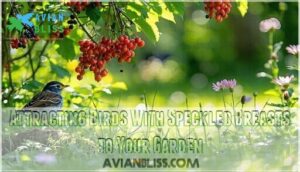This site is supported by our readers. We may earn a commission, at no cost to you, if you purchase through links.

These spotted patterns aren’t just pretty decorations – they’re nature’s camouflage system that helps birds blend into dappled sunlight and shadows.
Common species include the Wood Thrush with bold chocolate spots, the secretive Hermit Thrush with delicate flecking, and the Brown Thrasher’s rusty streaks.
Yellow-rumped Warblers sport subtle speckles during migration, while Eastern Towhees show distinct markings year-round.
Each species uses different habitats and foraging techniques, making identification easier once you know what to look for, and seasonal changes can dramatically alter these patterns and behaviors.
Table Of Contents
- Key Takeaways
- Birds With Speckled Breasts Overview
- Birds Mistaken for Robins With Speckled Breasts
- Songbirds With Speckled Breasts
- Thrushes With Speckled Breasts
- Warblers With Speckled Breasts
- Towhees With Speckled Breasts
- Birds With Speckled Breasts by Season
- Attracting Birds With Speckled Breasts to Your Garden
- Frequently Asked Questions (FAQs)
- Do birds have speckled breasts?
- What are speckled breasts?
- What bird has red breasts?
- What bird has a brown back?
- Why do birds have speckles?
- Do speckled breast birds migrate seasonally?
- What birds have a speckled chest?
- What kind of bird has a spotted breast?
- What bird has spots on its chest?
- Why do I have a Brown Thrasher in my yard?
- Conclusion
Key Takeaways
- You’ll recognize speckled-breasted birds by their distinctive spotted patterns, which serve as nature’s camouflage system to help them blend into dappled sunlight and shadows while avoiding predators.
- You can identify common species like Wood Thrush with bold chocolate spots, Brown Thrasher with rusty streaks, and juvenile American Robins with their temporary speckled plumage that changes as they mature.
- You’ll attract these birds to your garden by providing dense shrubs for nesting, berry-producing plants for food, and open ground areas where they can hunt for insects and worms.
- You should observe these birds throughout different seasons since their speckled patterns and behaviors change dramatically – juvenile birds often show more pronounced spotting, and migration patterns affect which species you’ll see when.
Birds With Speckled Breasts Overview
You’ll find that many bird species display beautiful speckled breast patterns, from the familiar American Robin’s juvenile plumage to the intricate markings of Brown Thrashers and Song Thrushes.
These distinctive spotted patterns serve important purposes like camouflage and species recognition, making them key features you can use to identify different birds in your backyard and beyond.
Common Bird Species With Speckled Breasts
Seven common bird species showcase stunning speckled breast birds patterns you’ll encounter regularly.
Robin Speckles appear on juvenile American Robins, while Thrasher Markings create bold streaks on Brown Thrashers. Northern Flickers display Flicker Spots across their chest, and Wren Patterns decorate Speckle-Breasted Wrens.
Thrush Distinctions help identify Song Thrush varieties. These bird plumage features make bird identification rewarding for backyard enthusiasts.
The Wood Thrush, known for its speckled breast, is native to North America.
Characteristics of Speckled Breasts in Birds
Most speckled breast birds develop their distinctive patterns through fascinating genetic processes.
Most backyard visitors earned their stunning spotted plumage through millions of years of evolutionary artistry.
These intricate feather structures serve multiple purposes in nature:
- Camouflage Function: Speckled breasts help birds blend seamlessly into dappled sunlight and shadows, providing essential predator avoidance.
- Speckle Variation: Bird coloration ranges from subtle cream dots to bold black markings, creating unique identification markers.
- Genetic Basis: DNA determines each bird’s specific plumage patterns, making every individual’s speckled breasts slightly different.
Features to Identify Birds With Speckled Breasts
Speckle patterns vary dramatically between species – some cluster near the throat while others scatter across the chest.
Bird size matters too; a speckled robin dwarfs a tiny wren.
Check breast coloration underneath those spots – cream, white, or buff backgrounds tell different stories.
Habitat clues and song identification complete your detective work, making bird identification foolproof during your next backyard adventure.
Birds Mistaken for Robins With Speckled Breasts
You’ll often spot varied thrushes and hermit thrushes in your backyard and mistake them for robins because of their similar reddish-orange breasts and speckled patterns.
These thrush species share the robin’s size and ground-foraging habits, but their distinct markings and behaviors help you tell them apart once you know what to look for, which can be a key factor in identification.
Varied Thrush Identification and Behavior
You’ll spot varied thrush by their stocky build and distinctive burnt-orange breast with a bold black band across it.
These solitary birds hop along forest floors, tossing leaves aside while hunting insects.
Their haunting, buzzy vocalizations echo through dense Pacific Northwest woodlands.
As detailed by National Geographic, they’re common in moist, conifer-dominated habitats.
Unlike gregarious robins, varied thrush exhibit more reserved social behavior, making bird identification easier once you know their habits.
Hermit Thrush Characteristics and Habitat
While varied thrushes grab attention with bold markings, Hermit Thrush birds offer subtler beauty through their speckled breasts and distinctive white eye-rings.
These thrush species prefer forest interiors where their haunting Hermit Thrush song echoes through trees.
Bird habitats and plumage variations help distinguish this bird species:
- Short, stocky build averaging 6.75 inches long
- Olive-brown backs with white, darkly spotted undersides
- Reddish wash on flight feathers and tail
- Nesting habits include ground-level or low shrub placement
- Migration patterns span boreal forests to mountain woodlands
Their conservation status remains stable across diverse bird habitats.
Songbirds With Speckled Breasts
You’ll find that songbirds with speckled breasts are among the most melodious birds in your yard, with the brown thrasher leading the pack as nature’s champion vocalist.
This remarkable bird can sing over 1,000 different songs while showing off its striking rufous back and heavily speckled white breast that makes identification easy once you know what to look for.
Brown Thrasher Appearance and Behavior
You’ll recognize the Brown Thrasher by its rust-colored back and heavily speckled breast covered in bold streaks.
This member of the Mimidae family flaunts bright yellow eyes that seem to pierce right through you.
Watch for their distinctive foraging habits as they use their curved bill to flip leaves and scratch through debris, hunting insects with determined persistence.
Brown Thrasher Song and Mimicry
Beyond its striking appearance, the Brown Thrasher’s song repertoire size rivals nature’s greatest performers.
You’ll hear over 1,100 different melodies from this Mimidae family member, each phrase repeated twice before moving on.
Their mimicry accuracy includes crude imitations of Northern Cardinals and Wood Thrushes.
Regional dialects vary across territories, showcasing remarkable vocal development through song learning.
Thrushes With Speckled Breasts
You’ll find several thrush species that display beautiful speckled breast patterns, with the varied thrush and hermit thrush being the most common examples you’re likely to encounter.
These birds share similar spotted markings but differ in their habitat preferences and foraging behaviors, making proper identification easier once you know what to look for.
Varied Thrush Habitat and Foraging
You’ll find Varied Thrush birds switching between dense forests and open areas based on season.
These speckled breast birds show fascinating Migration Patterns, moving from Forest Dependence in summer to diverse Winter Habitat locations.
Their Ground Foraging behavior reveals interesting bird diet preferences:
- Beetles and larvae found under fallen logs
- Seeds from coniferous trees during winter months
- Berries from shrubs in forest clearings
- Earthworms after rain softens soil
- Ants discovered beneath bark pieces
Hermit Thrush Diet and Foraging
Watching a Hermit Thrush hunt reveals nature’s precision in action.
You’ll spot these speckled breast birds using their keen eyesight to scan forest floors for insects and berries.
Their Seasonal Diet shifts dramatically throughout the year.
| Season | Primary Food Sources |
|---|---|
| Spring/Summer | Beetles, caterpillars, ants |
| Fall/Winter | Wild berries, small fruits |
Their Foraging Techniques involve patient ground-searching in dense, moist woodlands.
Their songs feature harmonic series patterns.
Warblers With Speckled Breasts
You’ll find that warblers with speckled breasts are less common than their thrush cousins, but they’re worth learning to identify during migration seasons.
The Yellow-rumped Warbler stands out as the most likely candidate you’ll spot, especially in fall when young birds show faint streaking across their pale yellow chests.
Yellow-rumped Warbler Identification and Habitat
You’ll spot Yellow-rumped Warblers by their bright yellow rump and crown patch. These charcoal-gray birds wear black face masks with white throats and yellow side spots.
Two warbler subspecies exist: Audubon’s warbler in western habitat and Myrtle warbler in eastern habitat. They prefer coniferous forests for breeding and shrublands during winter migrations.
Tennessee Warblers also favor coniferous forests, specifically dense spruce and balsam-tamarack bogs.
- Watch for that unmistakable yellow rump flash – it’s like nature’s built-in highlighter
- Listen for their soft chip calls echoing through pine and spruce forests
- Observe their preference for forest edges where sunlight meets shadow
- Notice how males show brighter yellow crowns during breeding season
Yellow-rumped Warbler Diet and Foraging
You’ll find Yellow-rumped Warblers are true food opportunists.
Their Winter Diet shifts dramatically from summer’s Insect Consumption to berry-heavy meals.
Watch their impressive Foraging Techniques as they hawk flying insects or glean from bark crevices.
- Fruit Preferences include bayberries, wax myrtle, and sumac during cold months
- Insects like beetles, caterpillars, and flies dominate spring breeding season
- Habitat Influence determines available food sources across different regions
- Bird Foraging happens at various heights from ground to treetops
Towhees With Speckled Breasts
You’ll find Eastern Towhees scratching through leaf litter with their distinctive black, white, and rufous coloring, though juveniles display the speckled breast pattern you’re looking for.
These ground-dwelling birds prefer dense undergrowth and forest edges where they can forage for insects and seeds while staying hidden from predators.
Eastern Towhee Identification and Habitat
The Eastern Towhee’s black hood and rufous sides make it stand out among speckled breast birds.
You’ll find this striking species in dense undergrowth from Georgia to Maine, with subtle Regional Differences in size.
Their distinctive "drink-your-tea" Vocalizations echo through thickets where they prefer Nesting Habits in low shrubs.
Perfect Eastern Towhee bird identification starts with recognizing their bold plumage patterns in typical bird habitats.
They’re ground foragers, often scratching through leaf litter for insects and seeds.
Eastern Towhee Diet and Foraging
You’ll find Eastern Towhees scratching through leaf litter like tiny rakes, using their powerful legs for ground feeding.
Watch these feathered excavators work their magic, turning quiet forest floors into bustling insect buffets.
These speckled breast birds switch between seasonal diet preferences throughout the year.
- Foraging techniques: They use a distinctive "double-scratch" method, hopping forward then kicking back with both feet
- Seed preferences: Acorns, dogwood berries, and sumac seeds dominate their plant-based meals
- Insect consumption: Beetles, moths, and caterpillars provide essential protein during breeding season
Birds With Speckled Breasts by Season
You’ll notice different speckled-breasted birds throughout the year as migration patterns and breeding cycles change their appearance and location.
Understanding seasonal timing helps you identify which species you’re likely to spot, from juvenile robins with their spotted chests in spring to wood thrushes passing through during fall migration.
Birds With Speckled Breasts in Spring
During spring migration, you’ll notice birds with speckled breasts displaying their finest breeding plumage.
Their spring diet focuses on insects for nesting habits, making birdwatching rewarding as these plumage patterns aid bird identification.
Juvenile speckling becomes prominent on American Robins, while Hermit Thrushes show distinctive breast spots. Lincoln’s Sparrows reveal ultra-fine streaks, and Clay-coloured Sparrows emerge in scrubby areas.
Birds With Speckled Breasts in Summer
Summer brings a parade of speckled-breasted beauties to your yard, each showcasing unique plumage patterns.
The vibrant Northern Cardinal’s red color comes from its diet.
Juvenile speckling helps young birds blend into their surroundings while parents focus on territory defense and nesting habits.
- Summer molting creates varied speckled patterns in adult birds
- Juvenile American Robins display prominent breast speckles until October
- Rose-breasted Grosbeaks frequently visit feeders during summer months
- Brown Thrashers remain abundant throughout eastern United States
- Summer diet includes insects, berries, and seeds for ideal bird identification
Birds With Speckled Breasts in Fall
During Fall Migration, juvenile American Robins display their signature speckled breasts before Molting Patterns transform them by October.
Hermit Thrushes showcase rusty tails with spotted chests, while Swainson’s Thrushes reveal pale eye-rings.
Food Availability drives these bird species toward berry-rich areas.
Rose-breasted Grosbeaks frequent feeders, and Redwings flaunt orange-red flanks.
Perfect timing for dedicated birdwatching and bird identification practice.
Birds With Speckled Breasts in Winter
Winter brings out nature’s toughest performers with their speckled Winter Survival gear. These hardy birds adapt beautifully to Food Scarcity and harsh conditions.
Spotting winter’s speckled champions involves:
- Tracking Migration Patterns as northern species move south
- Observing Cold Adaptations like fluffed feathers and huddled roosting
- Noting Plumage Changes that help with camouflage in snow
- Identifying reliable bird feeding stations they frequent
Attracting Birds With Speckled Breasts to Your Garden
You can transform your garden into a haven for speckled-breasted birds like brown thrashers, song thrushes, and juvenile robins by providing the right mix of food sources and shelter.
These birds need dense shrubs for nesting, berry-producing plants for food, and open areas where they can hunt for insects and worms on the ground, creating a suitable environment with the right mix of shelter.
Providing Dense Vegetation and Brush Piles
Dense shrubs and brush piles create perfect nesting sites and roosting cover for birds with speckled breasts.
Layer native plants at different heights to provide predator protection and microclimate control. Stack fallen branches loosely in quiet corners.
You can find various garden shrubs suitable for attracting birds.
This natural setup attracts backyard birds while giving birdwatching enthusiasts front-row seats to observe fascinating bird behavior and discover active bird nests.
Offering Food Sources for Birds With Speckled Breasts
Beyond shelter, you’ll want to roll out the red carpet with food that matches their seed preferences.
Berry bushes provide natural snacks, while insect feeders and suet recipes deliver protein-packed meals.
Don’t forget water sources for drinking and bathing.
Here’s your speckled-breast buffet lineup:
- Sunflower seeds – the gold standard that’ll have them coming back for more
- Mealworms – protein powerhouses that make parent birds sing with joy
- Mixed berries – nature’s candy that satisfies their sweet tooth
- Fresh suet – high-energy fuel for active foragers
Many enjoy offering seeds to birds.
Creating a Bird-Friendly Environment
Your bird-friendly space needs more than just feeders. Think of yourself as a hotel manager for feathered guests who demand premium service.
- Native Plants provide natural food sources and attract insects that speckled-breast birds love
- Water Sources like shallow birdbaths or dripping fountains create drinking and bathing opportunities
- Nesting Sites through dense shrubs and brush piles offer safe breeding locations
- Shelter Options with layered vegetation provide predator control and year-round protection
Consider purchasing native plants online to support local ecosystems.
Frequently Asked Questions (FAQs)
Do birds have speckled breasts?
Coincidentally, you’ve noticed those spotted patterns too.
Yes, many birds sport speckled breasts. American robins, song thrushes, and brown thrashers all display these markings.
It’s nature’s clever camouflage trick helping them blend into their surroundings perfectly, which is a result of camouflage.
What are speckled breasts?
Speckled breasts are feather patterns featuring small spots or dots scattered across a bird’s chest area.
You’ll notice these markings help young birds blend into their surroundings for protection from predators.
What bird has red breasts?
American Robins display bright red-orange breasts that catch your eye in gardens and parks.
You’ll also spot Spotted Towhees with their distinctive orange-red chests, making them easy to identify during your backyard birdwatching adventures.
What bird has a brown back?
You’ll spot several species with brown backs in your backyard.
Song thrushes display beautiful brown backs with speckled breasts, while brown thrashers showcase rufous-brown coloring.
These common birds frequent gardens and parks throughout North America.
Why do birds have speckles?
Over 70% of songbird species display some form of breast patterning.
You’ll find speckles serve as camouflage, helping birds blend into dappled sunlight and shadows while protecting them from predators during vulnerable moments like feeding.
Do speckled breast birds migrate seasonally?
Yes, you’ll find many speckled-breast birds migrate seasonally.
Northern flickers travel across North America, while robins head to Central Mexico after breeding.
Song thrushes move throughout Europe, and hummingbirds journey between South American countries.
What birds have a speckled chest?
Over 15 bird species sport speckled chests across North America.
You’ll spot Northern Flickers, Brown Thrashers, and juvenile American Robins displaying these distinctive markings.
Song Thrushes and Wood Thrushes also feature beautiful speckled breast patterns year-round.
What kind of bird has a spotted breast?
You’ll find several species with spotted breasts, including American Robins (juveniles), Brown Thrashers, Song Thrushes, and Northern Flickers.
These markings help with camouflage and vary by age, with young birds often showing more pronounced spotting patterns, which can be a key factor in their survival.
What bird has spots on its chest?
Over a dozen species sport spotted chests in North America alone.
You’ll spot American Robins with juvenile speckles, Brown Thrashers with bold streaking, and Song Thrushes with clustered black spots that create natural armor-like patterns.
Why do I have a Brown Thrasher in my yard?
Brown Thrashers visit your yard because you’ve got what they need – dense shrubs for nesting, open ground for hunting insects, and berry-producing plants.
They’re seeking food, shelter, and safe breeding spots.
Conclusion
Nature’s painted masterpieces flutter through your world every day, waiting for you to notice their intricate details.
Spotting birds with speckled breasts becomes second nature once you understand their unique patterns and behaviors.
You’ll find these camouflaged beauties in diverse habitats, from dense woodlands to suburban gardens.
Keep your field guide handy and practice patience – each sighting builds your identification skills.
Remember, seasonal changes affect appearance, so observe carefully throughout the year for complete understanding.
- https://www.google.com/url?sa=t&rct=j&q=&esrc=s&source=web&cd=&cad=rja&uact=8&ved=2ahUKEwih_YTA4_D6AhU_tmMGHaNlAacQFnoECCkQAQ&url=https%3A%2F%2Febird.org%2Fspecies%2Fspbwre2&usg=AOvVaw0p5XODcNzd0EG4_x_7IS0J
- http://www.biokids.umich.edu/critters/Turdus_migratorius/
- https://www.allaboutbirds.org/guide/Brown_Thrasher
- https://www.audubon.org/field-guide/bird/northern-flicker
- https://www.bbc.com/earth/story/20170109-the-reason-thrushes-make-so-many-different-songs

